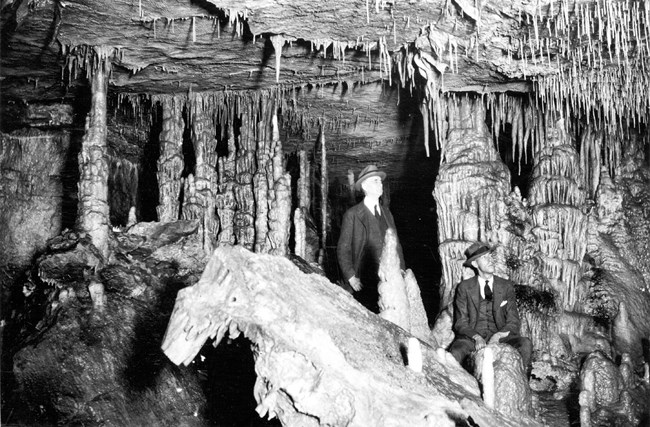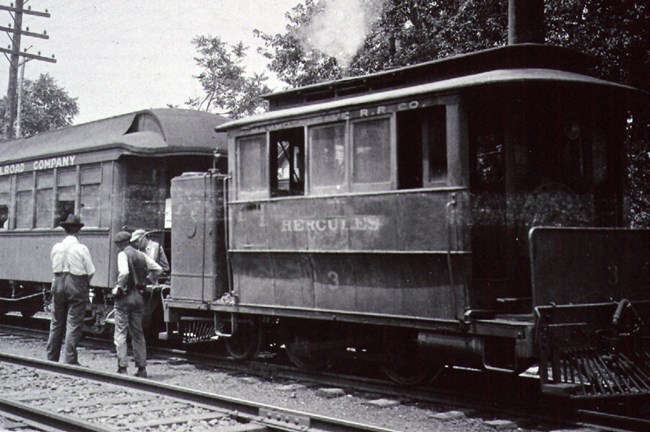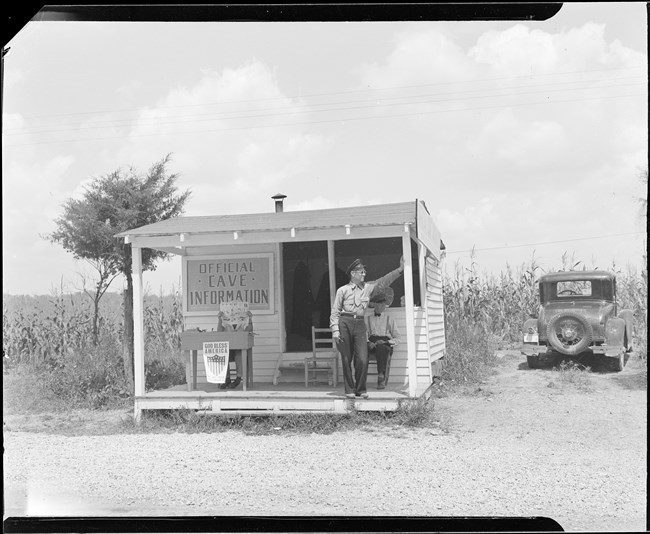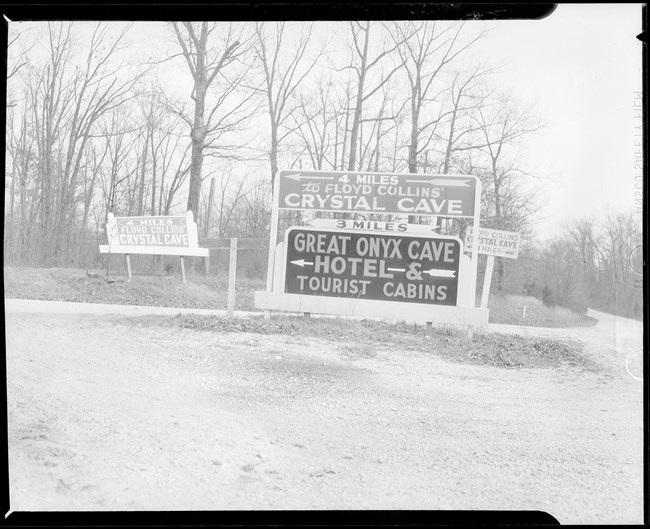Last updated: May 17, 2021
Article
The Kentucky Cave Wars
In the early twentieth century, an era of competition gripped the Mammoth Cave region. Rival cave owners battled in the courtroom, as well as along the roads, for the tourist dollars passing through Kentucky’s cave country en route to the future national park. Road signs and solicitors lined the highways to redirect travelers to one of many competing show caves. More than twenty caves were open to the public in the Mammoth Cave region by the 1920s, when the feuding reached its climax. Yet, the Kentucky Cave Wars had its roots in the nineteenth century, when cave developers and promoters first began siphoning tourists away from the world-famous Mammoth Cave.

Willis T. Lee, USGS, 1925
Finding Potential
Discoveries made around Mammoth Cave in the mid-nineteenth century created opportunities for enterprising cavers, landowners, and businessmen. As communities sprang up around Mammoth Cave, other caves were discovered, some with commercial potential. Smaller caves with an abundance of stalactites, stalagmites, and other speleothems could provide visitors to the region an alternative to the long underground treks through immense, dry passages typically experienced at Mammoth Cave.
Operating a successful cave business was also an attractive proposition for local landowners, as it had the potential to be much more lucrative than farming the rocky soils of the area’s ridges. By the onset of the American Civil War, several cave businesses such as Diamond Caverns, Indian Cave, and Hundred Domes Cave had opened to the public and were offering visitors a compliment to their Mammoth Cave experience with a trip into their smaller, showier caves.
Looking for Advantages
Guides and explorers continued to push the boundaries of Mammoth Cave in the nineteenth century, revealing even greater potential for commercial success for cave developers. After Stephen Bishop famously crossed the Bottomless Pit, opening the way to the underground rivers and the many passages beyond, expeditions into Mammoth Cave began pushing deeper and deeper – and farther and farther from the privately-owned Mammoth Cave Estate. Neighboring landowners understood that, while owning a smaller cave in the area could provide a good living, the real money was at Mammoth Cave. That was what people were traveling to see. By the close of the nineteenth century, the hunt for a “back door” to Mammoth Cave was the top priority for every would-be cave developer. As more and more cave businesses opened to the public, developers had to look for every possible advantage to outlast the competition.

Location, Location, Location
Success during the Kentucky Cave Wars was often determined by accessibility. If a cave was not near the stagecoach lines to Mammoth Cave, a business had little chance to survive. Later, it was necessary to have good positioning and a station on the Mammoth Cave Railroad line to have a real shot at success. The arrival of the automobile at Mammoth Cave in the early years of the twentieth century, however, gave more cave owners an opportunity to draw visitors to their underground attractions. Travelers no longer relied on others to determine the route they took to Mammoth Cave or where they could stop on their vacation, and even more cave developers joined in on the war for the tourist dollar.
George Morrison
The Kentucky Cave Wars earned their name and reputation when the competition reached a feverish pitch in 1915, upon the arrival of George Morrison to Mammoth Cave. While other cave developers, such as Larkin Procter, Lyman Hazen, and even railroad agents for the L&N Railroad, had found success in commercializing caves in the vicinity of Mammoth Cave, they’d all failed in their attempts to find a connection to the world-famous cave. Within six years of his arrival to the area, George Morrison had illegally gained access to Mammoth Cave, determined where the most remote passages lied in relation to the surface, obtained the rights to property along the Cave City Road, and blasted open a backdoor that he named the “New Entrance to Mammoth Cave.” Seemingly overnight, Morrison became the most successful cave developer in the region and continued to grow his cave empire with the addition of a hotel and more entrances to his beautiful section of Mammoth Cave.

NPS Photo/ #maca_30333B
Luring Travelers In
As the war erupted in the courtroom over Morrison’s use of the name, “Mammoth Cave,” the fighting also moved to the roadsides. The Mammoth Cave Estate, the New Entrance, and others relied more and more on reaching visitors as they drove to the cave region and depended on increased signage to get their attention. When that proved to be insufficient, solicitors (called “cave cappers” because of the hats they commonly wore) were hired to line the highways, draw motorists to their booths, and give “official cave information” intended to lure travelers to their cave of employment.
Positioning along the road was critical. If a cave business couldn’t employee cappers to draw tourists to their location, then a cave had to be conveniently located along the road. Unfortunately for the Collins family, owners of Great Crystal Cave, their business had neither advantage.
Tragedy in Cave Country
On January 30, 1925, Floyd Collins attempted to remedy his family’s situation by exploring Sand Cave, just off the Cave City Road, for potential development. Floyd’s journey into Sand Cave proved tragic, as his foot became pinned between a rock as he was exiting the cave. Floyd Collin’s entrapment, and subsequent death, became a national news phenomenon and drew thousands of spectators to the area. The failed rescue effort shed a light on the competition in the Mammoth Cave region and helped accelerate an already-growing movement to turn the area into a national park.

NPS Photo/ #maca_30629
The Tourism Legacy Continues
The Kentucky Cave Wars did not end with the creation of Mammoth Cave National Park in 1941 but continued to linger for the next several decades as former competitors closed, and some became incorporated into the national park. By the 1960s, however, the war had slowly come to an end, information booths and cappers began to disappear, and cave owners began looking for ways to cooperate and cross-promote.
Despite the damage done to lives, resources, and reputations, competition and conflict had driven the people of cave country to actively explore the region for nearly a century. Their discoveries shaped the understanding of the Mammoth Cave National Park’s resources and determined the tourist routes that continue to be shown to thousands of visitors annually.
The roadside solicitor has been replaced by the white-tail deer and the wild turkey. The scars of the past are disappearing, but the people and places in Mammoth Cave National Park will continue to tell the stories of the Kentucky Cave Wars for many generations to come.
